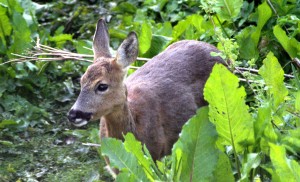 The roe deer doe and her last year’s kid ran across the road just in front of my car and then they both leapt the fence into our garden with ease. The doe looked almost scruffy in her brown/grey winter coat compared with what the summer coat would be, that very attractive foxy red colour. However the large white diamond shaped caudal patch was dominant and she also had a large white throat patch. This white throat patch varies with individuals and last year there was a doe in the garden with no sign of such a throat patch. Years ago to see a roe jumping into a garden would have been very unusual as this small deer was largely confined to woodland in the Highlands. Now they are not only seen on open moorland but also in towns and villages where they often invade gardens and even churchyards. Roe deer in such urban areas can cause damage to trees, shrubs and flowers, especially when they are there all the year round. There have even been reports of roe deer having and raising their kids in large gardens on the edge of Inverness. The reason for this dramatic change in lifestyle is not really understood but is probably because of the increase in numbers of roe deer and the very wide range they now occupy. There may now be more roe deer than either red deer or sika deer and they are certainly more widespread.
The roe deer doe and her last year’s kid ran across the road just in front of my car and then they both leapt the fence into our garden with ease. The doe looked almost scruffy in her brown/grey winter coat compared with what the summer coat would be, that very attractive foxy red colour. However the large white diamond shaped caudal patch was dominant and she also had a large white throat patch. This white throat patch varies with individuals and last year there was a doe in the garden with no sign of such a throat patch. Years ago to see a roe jumping into a garden would have been very unusual as this small deer was largely confined to woodland in the Highlands. Now they are not only seen on open moorland but also in towns and villages where they often invade gardens and even churchyards. Roe deer in such urban areas can cause damage to trees, shrubs and flowers, especially when they are there all the year round. There have even been reports of roe deer having and raising their kids in large gardens on the edge of Inverness. The reason for this dramatic change in lifestyle is not really understood but is probably because of the increase in numbers of roe deer and the very wide range they now occupy. There may now be more roe deer than either red deer or sika deer and they are certainly more widespread.
Roe deer are by far the smallest deer in the Highlands, much smaller than the red deer and sika deer. There have been rumours of the muntjac which is even much smaller than the roe but their presence has still to be confirmed. Roe deer have three different ways of showing they are alarmed which are also effective in showing it to other roe in the immediate area. They will often bark which is a distinctive gruff bark that may be repeated several times. Another alarm behaviour is to make the caudal patch larger by raising the hairs and this is known as “flaring”. This may be accompanied by the animal bounding along and leaping clear off the ground which is called “pronking”. Again both these behaviour displays are to warn others of danger.
Roe deer, like red deer, are native to the UK and the Highlands as opposed to the introduced sika deer. The roe deer bucks have very small antlers compared to the other deer but they may be short with only a few “points” but they are sharp and ironically roe can be much more dangerous than red or sika as they are smaller and more agile. They are difficult to contain which is why they have been kept in very few deer parks. The short antlers of the roe buck are very much prized by sportsman and they have a world wide reputation for their size and conformation. Roe antlers are cast in November and grown again by March. Being small and blending in well, the cast antlers are far more difficult to find than those of red or sika. The deer themselves, both does and bucks, will nibble the antlers for their calcium and other animals such a mice and red squirrels will also chew them. Interestingly whilst red and sika deer venison are well known and used, it is the roe venison that, unlike in the UK, is much favoured abroad and fetches much higher prices through the various game merchants.
Tags: highland wildlife
